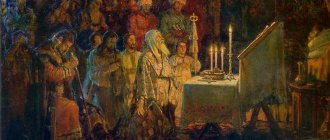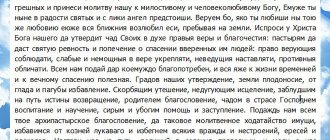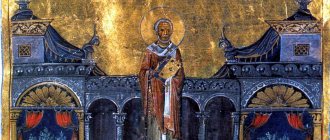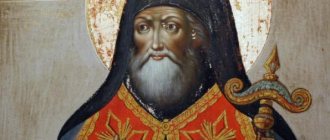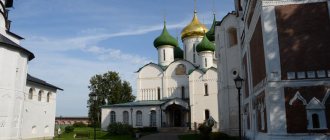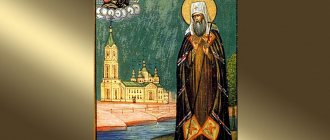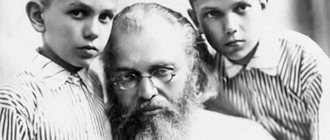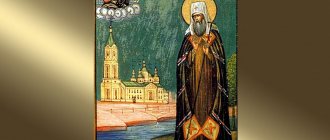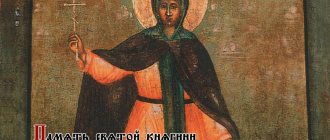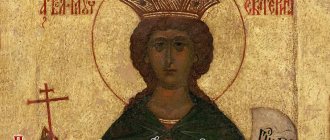In 1996, a fourteen-year-old girl who was possessed by demons was brought to the monastery. She participated in Satanist gatherings, and her mother did not know what to do with her. She was brought to the monastery in Ostrog, but such devilish power did not allow the men to bring her into the church.
The priests served a prayer service near the car in which she was sitting. They watched the girl all night, she did not sleep, she screamed all night. On the second day they wanted to touch her to the relics, but she couldn’t. Only the next day she was able to venerate the relics. Only after this did the evil forces let her go.
Saint Basil of Ostrog is a saint of the Serbian land. Currently, healings are taking place from the relics. Every year they bring more and more news about his miracles. To this day, people rush to the Ostrog monastery to venerate the relics of St. Basil. Memorial Day of the saint in the Russian Orthodox Church on May 12.
Basil of Ostrog - saint of the Serbian land. His memory is celebrated on May 12
Birth of boy Stoyan
The future Saint Basil of Ostrog was born at the end of 1610, namely, on December 28. At birth the boy was given the name Stoyan. Stojan Jovanovic's father and mother - Peter and Anastasia - were pious people and taught this to their beloved son. So fasting and daily prayers were familiar to the boy from early childhood.
Fellow villagers in the village of Mrkonjic in Popov Polje (Herzegovina) loved Stoyan for his kindness and willingness to always help. But, as happens always and everywhere, there were also ill-wishers in the village. In addition, the Turks ruling the Serbian land introduced a conscription under which they could freely take any person in order to train him in military affairs and make him a Janissary. At the same time, it was believed that it was necessary to change faith from Orthodoxy to Islam. This was even done by force.
Rules of prayer
It is better to pray in front of the icon of Vasily Ostrozhsky, which is purchased in a church shop. To make your prayers to the saint faster, you should follow certain recommendations:
- make the request sincerely, from the bottom of your heart;
- have bright intentions, not wish harm to anyone;
- pray with strong faith, otherwise nothing will work out;
- pronounce sacred words consciously.
After the assistance provided, you need to say a prayer of gratitude. A special sacred text or your own words will be suitable. The prayer words created on the day of remembrance of the saint are especially powerful.
Study and life in the monasteries of Zavala and Tvrdosh
Stoyan was the only, long-awaited child in the family, and his parents did not want to be separated from him under any circumstances. But in order to save the boy from the Turks and, observing his behavior, the loving mother and father decided that it would be better to send their son to study at the Zavala Monastery (Manastir Zavala), this is modern Bosnia and Herzegovina. Moreover, the boy’s uncle Seraphim then served as abbot of this monastery. This happened when the boy was 11 years old, in 1622.
There were workshops at the monastery where you could learn some craft. In addition, there was a large library there, which gave the young man an amazing opportunity to read, learn new things and study. So the Zavalsky Monastery at that time was a center of education for young people.
After spending several years in the Zavala monastery, Stoyan Petrovich Jovanovic left in 1625 for another monastery called Tvrdosh. At that time, it housed the residence of the ruling bishop of the Trebinj diocese. Here an important event took place for the young Stoyan: he took monastic vows, taking the name Vasily in honor of Basil the Great, a saint of the 4th century.
Let me digress a little, this interesting fact is known. In the family of Basil the Great, if you count him together, there were 10 children. 5 boys and 5 girls. Of these, 5 people were subsequently canonized. Can you imagine? This is family, this is parents, this is upbringing!
Very soon, after arriving in Tvrdosh, Monk Vasily became a deacon, and then accepted the rank of hieromonk.
What happened in the Cetinje Monastery
After some time, leaving this monastery, the Monk Vasily went to the Cetinje Monastery. At that time, Mardariy was the Metropolitan of Montenegro. Here, on the one hand, a very unpleasant, and, on the other, an amazing incident occurred, which revealed to people the extraordinary power of the young priest.
At this time, with the connivance of Mardarius, the Jesuits actively promoted the signing of the union. Vasily told Mardari more than once to pay attention to this and stop this heresy. But his words and requests were never heard by the Metropolitan.
And then this story happened. Contrary to existing rules, Mardari sinned with the maid. The woman became pregnant, and the secret became known to everyone. To avoid punishment, the Metropolitan decided to cheat and added another to one of his sins: he shifted his guilt onto Vasily. Naturally, the words of Mardari as the Metropolitan of Montenegro did not raise doubts in anyone.
At that time morals were harsh. The young man was found guilty and sentenced to death by hanging. He asked to postpone the execution until the birth of the child. It's interesting, but basically everyone agreed with his request. People believed the miracle worker, they saw that he lived by his faith and simply could not sin.
And then the baby's birthday came. The miracle worker took the baby in his arms, blew on him and asked him to tell him the name of his father. “Kornetsky lord,” the newborn answered, to everyone’s amazement, calling out the nickname Mardaria.
I repeat, times were hard, morals were cruel - Mardari was stoned to death. Vasily was acquitted, and he went to the Tvrdosh monastery, where he soon became an archimandrite.
Features of the trip
You can get here by excursion bus or by your own car. The road to the monastery is absolutely safe and simple, it goes quickly and without problems. All you need is a map with a route.
There will be from 20 to 40 people on the tour bus . Then there will be experienced guides who will tell a huge number of stories about the place and answer any questions that arise. You should also choose a convenient time to travel to the monastery: usually after lunch.
Many pilgrims get here by bus, but it is believed that a true committed traveler will come here on foot. Some walk barefoot, because it is believed that the soul of a person who has walked this path, sometimes even on his knees, is freed from sins. Many stay here overnight to spend this time with Saint Basil, gain strength, grace and start a new life.
Usually during the day a huge queue gathers here to enter the monastery, receive grace from St. Basil and be saved from the persecution of grief.
Travels of Priest Vasily
Having taken up his new duties, the Monk Vasily saw the plight of the church: there were not enough church utensils, there was not even clothing for performing Services. After several years, Vasilije Ostroški (Serbian pronunciation) went to the holy Mount Athos.
On the way, he stopped in the city of Pec, where he met with Patriarch Paisius 1 Janjevac. Together they talked for a long time about the plight of the Orthodox people under Turkish oppression. Soon Paisius released the young man on a long journey. But with only one condition - be sure to return to your native land.
Having reached the goal of his journey - St. Athos - Vasily visited many monasteries, receiving new knowledge there and meeting different people.
After this, Archimandrite Vasily made a trip to the Russian lands, hoping to receive at least some help from the fraternal Russian people. The results of this trip exceeded all expectations.
After a while, when he arrived home, he brought with him many gifts: church books and clothes for church ministers, as well as a large sum of money. All these funds were used to restore Orthodox churches in the country oppressed by the Turks and open schools for children there.
How to get there
Pilgrims are often interested in the question of how to get to the Ostrog Monastery. The easiest option is to sign up for a tour. It’s not enough to find a monastery on a map of Montenegro - you need to plan a route correctly. The terrain here is difficult, there is a risk of getting lost. In addition, there are many serpentines in Montenegro, along which you need to move with caution. When tourists go with a guide, they are held accountable. Vacationers are taken along a proven route.
Tourists usually pass through Podgorica. Many pilgrimage excursions are arranged in such a way that tourists are shown shrines, and at last they leave the most important one - the Ostrog Monastery. Here you can see the most serious evidence that miracles exist. People want to see evidence of faith overcoming obstacles.
Youngest bishop
In 1638, on the Feast of the Transfiguration, twenty-eight-year-old Vasily was ordained bishop. Although, according to canonical rules, this is possible no earlier than when the applicant reaches 30 years of age. But the patriarch, as an exception, seeing the holiness and piety of Vasily, slightly changed the rules that had existed for a long time.
The residence of the new bishop was the monastery in Tvrdosh. But having received this rather high rank, the miracle worker, just as before, went around the surrounding villages, came to people and taught them Christian commandments, preaching Orthodoxy.
Atrocities of the occupiers
As before, Saint Basil began to lead the Services, although he knew that his actions were displeasing the Turkish authorities, from whom he had already received threats more than once. Meanwhile, the Turks were already openly simply killing Orthodox priests: they killed the Patriarch of Constantinople Kirill Lukaris, tortured and killed the Metropolitan of Eastern Herzegovina, and hanged the Serbian Patriarch Gabriel.
In 1662, the Turkish conquerors committed another atrocity. Reveling in his power and impunity, in the north of modern Montenegro, the Muslim ruler exterminated 67 elders. Some of them were simply killed, some had their stomachs ripped open, some were impaled. It was a scary time.
In addition, the unexpected happened: in the Tvrdosh monastery there were rumors that Vasily was allegedly conducting secret correspondence with the Vatican, trying to quickly sign a union with them. For the archpastor, this was a stab in the back from his brothers. He never expected this!
Moving to Ostrog
Construction of the monastery
As a result, all these newly emerging circumstances forced Bishop Vasily to move to Mount Ostrog, where the monks, led by Abbot Isaiah, already lived. In general, there was no monastery there in our understanding of the word. Then this place was called the Ostrog caves or, in another way, the Ostrog desert.
To this day, the cave of St. Isaiah of Onogosht has been preserved in the Ostrog Monastery. It’s amazing how in those distant times people settled literally on steep cliffs.
Having renovated the Church of the Entry into the Temple of the Most Holy Mary, the wonderworker built and equipped a new temple of the Honest Life-Giving Cross. He performed all the work on the construction of temples on an equal basis with all his brothers, despite his high rank.
It was through his efforts and concerns that a real monastery was erected on Mount Ostrog, to which now, in our days, almost a million pilgrims come annually.
The Ostroh monastery looks so elegant and almost unbelievable today: the snow-white stone walls of the monastery are literally built inside the rocks. And this is what the Ostrog Monastery looked like at the end of the 19th century.
At the monastery, Vasily Ostrozhsky healed the sick with prayers, helped people with advice to survive some difficult periods in their lives, and predicted some future events. But there were also dissatisfied people.
A story with a happy ending
At that time, a prince named Raich lived not far from the monastery. He had 6 sons. And somehow the monastery bothered him. For any reason, in every way available to him, the prince perpetrated all sorts of intrigues on the monastery and its inhabitants.
And he was so tired of him with his nagging and unfair accusations that, being once again in the city of Pecs with Patriarch Maxim, Vasily turned to him for advice: what to do, how to act in this case?
The Patriarch immediately wrote an angry letter to the prince, in which he forbade him to cause any damage to the monastery or its inhabitants. And he even threatened him with a curse and all sorts of troubles that could befall the prince in case of disobedience. And Vasily himself said more than once that trouble awaited the prince if he did not stop harming the inhabitants of Ostrog.
Having received the patriarch’s letter, Prince Raich came to Vasily, brought expensive gifts and asked for his forgiveness for a long time. But apparently repentance came late, and soon five of his sons died.
Having learned about such a misfortune, Metropolitan Vasily began to pray to God. And he told the prince to repent for himself and for his sons. The time will come and the prince will marry again. He will have more sons. That's exactly what happened. Very little time passed and Vasily Ostrozhsky performed the wedding ceremony of the prince with his new wife, and soon baptized their 2 sons.
Life after death
The Serbian Saint Basil of Ostrog died on May 12 (April 29, old style) 1671 and, as is customary in Orthodoxy, his body was transferred to the earth. But this is not the end of the story.
Seven years after his death, Metropolitan Vasily appeared in a dream to the monk Raphael and asked to reveal his burial. The monk did not believe his dream, and Vasily appeared to him again with the same request. The incredulous monk again took no action.
Then St. Vasily Ostrogsky appeared to him for the third time. He was wearing the elegant clothes of a bishop, and in his hand he held a censer. Repeating his request, Vasily doused the monk with heat from his censer. Apparently, for greater persuasiveness. And it brought results.
Waking up with pain in his burnt hands and his face aching as if from a burn, Raphael finally realized that all this was not without reason and went to Ostrog. There he spoke about his vision.
After the ritual necessary in such cases, the coffin with the body of Vasily Ostrozhsky was opened. And everyone present saw his body incorruptible, unchanged during these 7 years. Then, with great care, with solemn prayers, the body was dressed in elegant clothes, placed in a shrine and placed in the Vvedenskaya Church of the Ostrog Monastery in Montenegro. The relics are still there today.
And at the burial site of the Serbian saint, a grape tree grew right in the rock. And to this day it grows and bears fruit!
Moreover, the vine has amazing power and can heal those who turn to St. Basil with faith and prayer. And many women who could not conceive and give birth to a child for a long time, having visited this amazing tree, return to the Ostrog Monastery with their born babies. Such miracles happen here through the prayers of the Saint!
Rescue of holy relics
From the very first days after the discovery of the relics of St. Vasily, people, having sincerely prayed in front of the shrine, received healing and moral support from the Serbian heavenly patron. Knowing this, the enemies of the Serbian people tried in every possible way to destroy them. Several times since the discovery of the relics, the inhabitants of the monastery hid them as best they could from enemy attacks.
So, in 1714, saving the relics from the Ottomans, they were hidden on the banks of the Zeta River. Over time, the river flooded and water washed over the place where they were hidden. But when, a whole year later, the relics were returned to the Ostrog Monastery, it turned out that they were not damaged in any way. Neither time nor humidity caused any damage to them.
The second time, in 1852, when the Turks invaded Montenegro, the monks again had to hide the relics of the wonderworker Basil of Ostrog from desecration. The 100 inhabitants of the monastery fought off attacks by the 6,000-strong Ottoman army for several days. But when another 17 thousand Turks approached the walls of the monastery, the monks realized that they would not be able to hold the defense for long.
By secret paths they carried the relics of St. Basil to the Cetinje Monastery, where they remained safe until the liberation of Ostrog. For the third time, in the summer of 1877, the relics were again hidden from the invaders in the Cetinje monastery.
general information
The monastery is located at the base of the Ostrog mountain range, at an altitude of just under a thousand meters above sea level. This place has almost always served as a home for monks. The monastery literally hangs on a high steep cliff, for which pilgrims often compare it to the famous Greek meteors and call it the church in the rock of Montenegro.
The monastery has two levels:
- Lower Temple.
- Upper Temple.
The distance between them is 600 meters. Baptisms are held in the Lower Church, and the relics of Vasily are kept in the Upper Church. There is also a spring with holy water on the territory of the monastery, and anyone can easily draw liquid from there.
There is a place where you can spend the night and many shops where you can buy church souvenirs, books, and icons. They may also offer special oil. It has an unusual effect: it helps to get rid of pain very quickly if you use the product during a massage.
Here you can also encounter a picturesque view: a mountainous area full of trees, shrubs and grasses; and in the evening there will be cool weather and beautiful sunsets. You should also not forget about the architecture of this place, which forms a huge part of the world's cultural heritage. Anyone can stay here overnight in a hotel.
The healing power of the saint: many miraculous healings
The great veneration of the Ostrog miracle worker and the healing power of his relics made the monastery of Basil of Ostrog in Montenegro one of the most visited places in the country. And baptized, and unbaptized, and Orthodox, and Muslims, Buddhists and Catholics, turning to the saint for help, reading prayers to him for help in business, about marriage or infertility, reading an akathist, troparion or canon, or better yet, simply sincerely turning to your own, With words coming from the heart to Saint Basil, people receive healing and support. The Miracle Worker, as always, helps!
And what’s surprising is that the person’s personal presence is not necessary. Of course, this would be desirable, but circumstances in life are different.
For example, a woman who came to Ostrog blessed pieces of sugar at the relics and asked the saint for help for her grandson, who sometimes had unbearable headaches . She brought sugar home, and the boy’s parents gave him a sweet piece every day, accompanied by prayers. And there was no more pain, the boy recovered!
For more than three centuries, people have been coming to Saint Basil in an endless stream. Many books have already been written about the lives and miracles of healing of those suffering at the relics of the saint. All this information is recorded in the chronicles of the monastery. And they are replenished and replenished with new entries.
Doctors gave one person a depressing diagnosis: paralysis . Official medicine was unable to help him. Relatives, seeing his torment, offered to take the man to Ostrog. He categorically refused, saying that he did not want to, because he did not believe it.
But a few days later, at night, in a dream he saw Vasily of Ostrog, who called him to the monastery to heal. Waking up, the man asked to be taken to Ostrog. There he confessed and spent one night near the relics, without ceasing, reading prayers. Soon he was well.
And this story, recorded in the chronicles of the monastery, took place in the 30s of the 20th century. After the prayer at the relics of the miracle worker, a man who had previously been mute !
In May 1964, a Muslim woman, Fatima, was brought to venerate the relics of the wonderworker Vasily. She had sudden spasms throughout her body that prevented her from living a full life. Before Fatima came to the Ostrog Monastery, the illness had lasted for five years. The doctors could not help her, since the cause of the seizures could not be established.
Approaching the gates of the monastery, Fatima began to struggle and constantly repeated that she did not want to go there. Somehow she was led to the healing relics and, after much persuasion, the woman agreed to venerate them. After this, the prayer required in these cases was read over her.
Unexpectedly, Fatima began to kiss the ark with the relics, then she stood up and quite calmly said the following words: “Glory to God and Saint Basil! I am healthy!" She went home as a completely healthy person.
Godly deeds
Many pilgrims came to Ostrog to visit the saint. They were looking for consolation and help in various misfortunes. Vasily did not deprive anyone of attention. He helped everyone with his advice and often gave alms. He also called on believers to be merciful. Taking part in the construction of temples, he carried stones with his own hands.
The saint made a huge contribution to the preservation and unity of the Orthodox Church. At a time when Catholic Jesuits sought to impose their principles on religion and the Ottoman Empire tried to conquer the country, he did everything possible to strengthen Orthodoxy.
Memory of the Great Saint
In Montenegro
In memory of the great saint, churches bearing his name were built in many cities of Montenegro and beyond.
The church in Belgrade (Church of St. Basil of Ostrog in Belgrade) has the shape of a rotunda. She (Tsrkva svetog Vasilija Ostroshkog - in Serbian) even has her own choir. There is a bell tower on the side. The entire architectural ensemble is surrounded by a beautiful park.
The Ostroh Church is located at the address: Serbia, Belgrade, Partizanske aviјatsie, 25. Coordinates: 44.82035, 20.38793.
The cathedral in Niksic (previously this city in Montenegro was called Onogosht) was built in 1900 on the initiative of Nikola 1 Petrovic Njegos. Russian Emperor Alexander III financed this construction. The Saborna Church of St. Basil Ostroshki became a kind of monument to all the Montenegrin heroes who died in the fight against foreign invaders. Memorial plaques with their names are installed on the sides of this church.
The cathedral is located near the royal palace of Nikola-1 in the city of Niksic, on the Petrova Glavica hill. Coordinates: 42.77008, 18.95265.
church of St. Basil of Ostrog in Dobrota is very interesting . This small temple is located in the city cemetery. The belfry with two bells is located directly above the entrance and stands out for its original stone decoration.
The Church of Svetog Vasilija Ostroshkog near Dobroti has another unusual detail in its design. Above the entrance of the Church of St. Basil of Ostrog (English) there is a delightful mosaic depicting Basil of Ostrog against the backdrop of the monastery he founded.
You can enter the Church of St. Basil of Ostrog (Montenegro) only for the Divine service held there on Sundays at 8 a.m. But the entrance to the chapel located to the left of it is possible at any time.
Coordinates of the Church of St. Vasily Ostrogsky in the city of Dobrota (Montenegro): 42.44619, 18.76665.
In Russia
Not only in Montenegro is Vasily Ostrogsky revered. In Russia there are also churches consecrated in honor of this saint. Not many, of course, but they are there. Relatively recently, a church in the name of Vasily Ostrozhsky opened in Novosibirsk. Moreover, it is interesting that the temple was originally planned to be consecrated in honor of another saint. But, apparently, the Serbian saint Basil, the Wonderworker of Ostrog, decided that the cities of Russia also really needed his patronage! And a series of unexpected events led to the fact that the Novosibirsk temple was ultimately dedicated to Vasily Ostrozhsky.
I hope this article was interesting for you and helped you learn more about another of our heavenly protectors - St. Basil of Ostrog, Metropolitan of Zaholmo-Herzegovina.
My trip to the Ostrog rock monastery, where I already “met” the Serbian wonderworker Vasily in person, took place on February 13, 2022.
The map below shows other attractions of Montenegro that I was able to visit.
Share in the comments below which Christian saints you revere, whose lives made the greatest impression.
